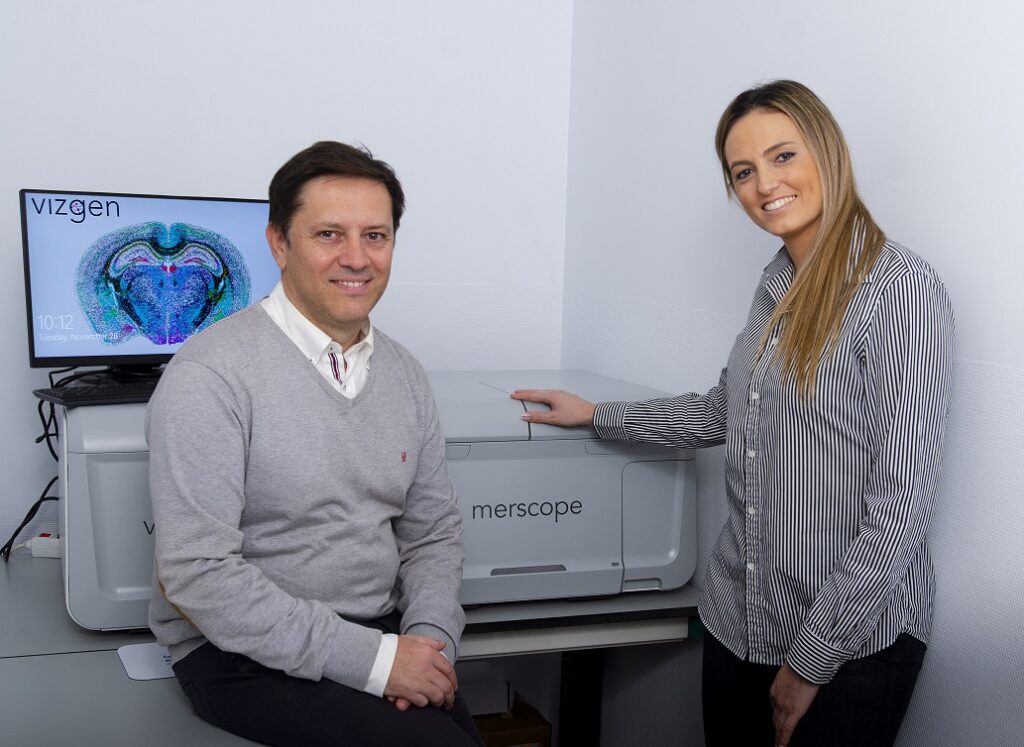The Institute for Neurosciences CSIC-UMH and Izasa Scientific join forces and bring MERFISH® spatial transcriptomics to Spain
14 de December de 2023
• It is the first device that offers this technology in the Iberian Peninsula and is located at the Institute for Neurosciences.

José López-Atalaya, scientific director of the IN Omics Facility, and Sara Manzanares Estreder, Key Account Manager of Izasa Scientific, together with the MERSCOPE equipment located at the IN.
The alliance between the Institute for Neurosciences (IN), a joint center of the Spanish National Research Council (CSIC) and the Miguel Hernández University (UMH) of Elche, and the distributor Izasa Scientific has made possible the arrival of MERSCOPE® to Spain. MERSCOPE®, which is already in the IN facilities and will be available starting next January, is a platform developed by Vizgen, a spin-out of Harvard University (USA), that allows the detection of tens to thousands of RNA molecules directly in tissue and with subcellular resolution.
This device uses MERFISH®, a massively multiplexed single-molecule imaging technology for spatial transcriptomics capable of mapping and quantifying the spatial distribution of hundreds to tens of thousands of RNA species in individual cells, without the need for subsequent sequencing. The phenotype of a cell, the fundamental unit of tissues, is determined by its transcriptome. Spatial transcriptomics technologies make it possible to obtain the gene expression profile of all the cells that make up a tissue in their context.
“These techniques, which represent a differential technological leap, offer us the possibility of obtaining a greater understanding of the organization and function of highly complex tissues such as nervous tissue”, explains José Pascual López-Atalaya, scientific director of the Omics and Gene Analysis Facility and principal investigator of the Cellular plasticity and neuropathology laboratory. The researcher highlights that spatial transcriptomics is currently being used in fields such as neurosciences, oncology, immunology, and developmental biology.
Watch explanatory video:
“In addition to revealing the molecular architecture of tissues, these technologies are contributing very significant advances to the understanding of the molecular bases of Alzheimer's disease or the importance that the tumor microenvironment plays in cancer progression, among other examples,” points out López-Atalaya. Spatial transcriptomics represents a true revolution in the field of biological research and that is why it was highlighted as the method of the year 2021 by the journal Nature.
With this recent addition, the IN's Omics and Gene Analysis Facility becomes the first Spanish facility in which it is possible to use this technology. This cutting-edge tool joins a set of cutting-edge equipment that allows researchers to analyze genomic and transcriptomic aspects of fixed cells, disaggregated living tissues, cultures and cellular organelles. Besides, the service has high-performance workstations and software packages for data analysis.
Izasa Scientific, a Werfen Company, is a Spanish multinational founded in 1966, a leader in the distribution of equipment for research and quality control in the Iberian Peninsula. This multinational, present in the main markets of Human Health and Biotechnology, Chemicals and Energy, Agri-food, Environment and Energy, and Industrial Quality Control, works with world-renowned manufacturers and covers the pre-sale, sale, and post-sale of equipment, to provide solutions to the scientific-technical community.
More information: omics@umh.es
Source: Institute for Neurosciences CSIC-UMH (in.comunicacion@umh.es)

 Español
Español
